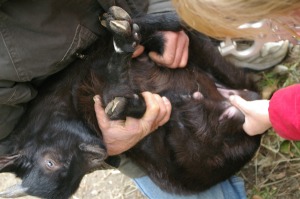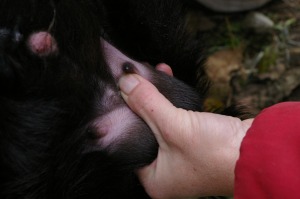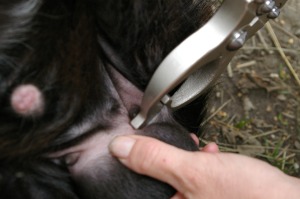On October 11th, my birthday, my goat kids turned 12 weeks old. This was as old as I could safely let them get with in-tact testicles and not run the risk of them impregnating their mothers or sister; or at least that’s what my research tells me! So, happy birthday to me, I spent the morning castrating my goats.
Some advise separating the bucks from the does at 3 months old, emasculate at 4 months old, and then butcher at 5 months of age. However, I do not have the facility to separate the bucks from the does so I decided to play it safe and castrate them at 12 weeks old. This way, I know for certain that they will not breed with my does.
It was a miserable process, likely worse for me than the kids. Yes, they cried out when the clamp was on–and as they did I nearly cried myself–but relief seemed immediate the second the clamp was released. The look on their faces frightened me because I thought they were going into shock. If the pitiful wails weren’t enough to tear my heartstrings, looking into their eyes when they stopped crying and withdrew deeply into their minds–mentally checking out–nearly did me in. However, I’m happy to report that within a minute or two of letting them go, each kid was back at the feeder and frolicking around the paddock in search of fodder. They did ‘walk like cowboys’ for a few hours that first day but by the evening they looked as good as new and had even forgiven me for doing it, running over and snuggling with me when I went to check on them that night.
Note: I have read a lot of different articles on this subject and bought the “Veterinary Guide for Animal Owners” by C. E. Spaulding, DVM and Jackie Clay, before attempting this procedure.
Step 1: Some advise to wash the testicles since the emasculator, in my case the Ritchey Nipper (or Side Crusher as they are called at Premier One where I bought mine) can break the skin. In my case, I did not wash the testicles beforehand and I did not have any broken skin.
Step 2: Have someone hold the goat by the hind feet with the goat laying back into their lap.

The easiest method of holding the goat kid in preparation for castration.
Step 3: Take the scrotum in one hand and find the spermatic cord with your other hand. Be sure the testicles are down into the scrotum and hold them in place with your hand. Move your fingers above the testicle and find the spermatic cord (you may need to use two hands for this). Once you have the cord identified, place it in between the fingers of the hand that is holding the scrotum.

Finding spermatic cord. Note the tiny teat that is above the testicle and my left thumb in photo.
Step 4: Place the Ritchey Nippers over the cord and clamp it down firmly. Check to be certain that you have the spermatic cord between the nippers and that it hasn’t slipped off to one side and avoided being crushed. Hold the nippers clamped in place for 20-30 seconds. Be sure not to clamp the tiny teat with the nippers; clamp below the teat and above the testicle. Then repeat on other side.

Holding the nippers in clamped position making sure the spermatic cord is under them.
The Ritchey Nippers work by crushing the spermatic cord thereby cutting off the blood supply to the testes. The testicles will eventually atrophy due to the lack of blood supply. The scrotum however will be visible for the rest of the animal’s lifetime. Although this is supposed to be a bloodless method, my research reveals that you can break the skin. Be sure to check each animal for broken skin and apply antiseptic and give the kid an injection of tetanus antitoxin if broken skin is found.


Oooooh, and I thought tagging my pigs’ ears was bad!
It’s scary how trusting animals are, when you consider what we do to them, and yet they still love us.
I believe that animals are the ones who can teach us about unconditional love and the only sentient beings who have the ability to give that!
Look forward to hearing about your moose hunt! I’m drawn for calf-moose again this year, so will be out the first week of Nov for a couple days. Good luck!
Boy, where are you that allows calf hunts!? We’re very restricted here and only bull hunts and LEH tags are issued to a limited number of hunters.
Pingback: Bloodless Castration | All Things Goat
Here answering your question from my blog.
We only hung ours overnight. If your temps will be under 45F you can hang for a few days, up to five.
Made a goat curry today! It was very tasty.
I have just found your blog through a link at all things goat. We are new to goat-raising and are learning everything we can. Our one buckling is a month old and we plan to castrate at about 12 weeks also. My question is, when using this method, do the goats retain that awful “buck” smells since they still have their scrotum/atrophied testicles or does this work as well as regular castration or banding.
I hope this isn’t a dumb question, like I said, we are new to this and this is our first boy kid.
I love the idea of “bloodless” castration.
Thanks so much!
No they don’t keep the smell which is why most people keep whethers instead of bucks. One of the reasons the bucks smell is because they pee all over themselves. In the goat world, buck pee doubles as aftershave! The whethers don’t do this.
Thank you! Ordering my side crushers now!
I usually band my bucks, but I believe this may just be a little better’n that especially for older males. Thanks for the tutorial!
Is the side crusher better than the emasculator also sold by Premier?
Hello Nancy,
I have only used the side crushers so I am unable to advise which is better for you. I know I have 100% success with them so can’t complain.
Kristeva
Thank you for sharing what you know so many people benefit.
Wanted to thank you for the explicit details for using the emasculators. We have 5 bucklings to do that are about 6 weeks old and thought we’d rather do this than cut them as when the vet did that last year it not only cost us $$ but we almost lost one to bleeding to death. Only by the Grace of God and the Phosphorus that I used did we save him, poor thing. Will be doing CDT shots this weekend and then have the Tetnus Toxoid on hand if needed. Thanks again.
Nicki